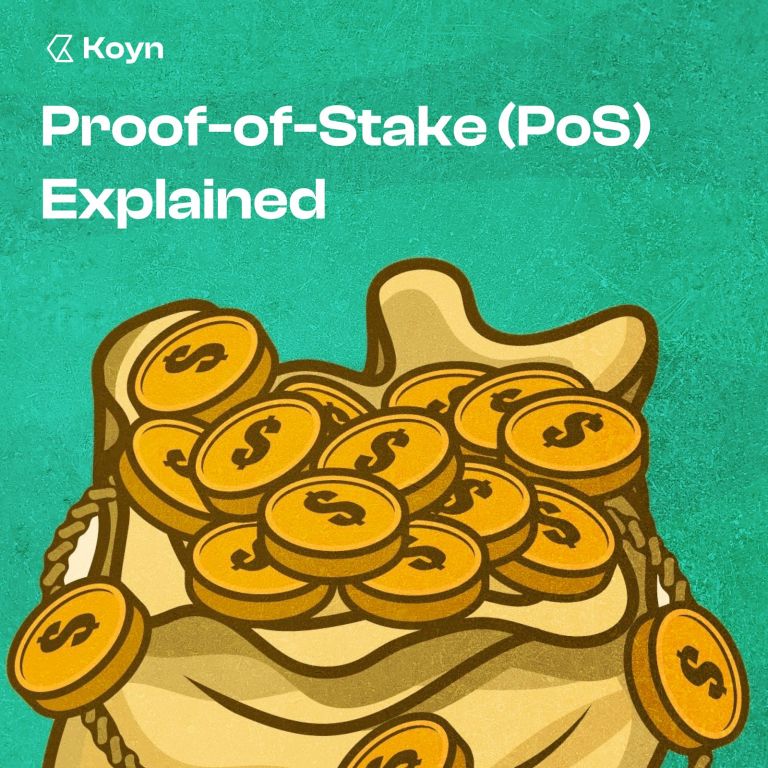Since proof-of-work (PoW) became popular in 2009 when Bitcoin went mainstream, there have been numerous concerns about its sustainability. Proof-of-stake (PoS) was developed in 2012 as a solution to Bitcoin’s high energy consumption. The efforts appear to have been successful because PoS has been adopted by many blockchain networks for its energy efficiency and scalability.
KEY TAKEAWAYS:
- Proof-of-stake (PoS) is a consensus mechanism that allows validators to verify transactions by staking their coins as collateral.
- PoW was primarily created to resolve proof-of-work’s (PoW) problem of sustainability and high energy consumption.
- Advantages of PoS include better decentralization, security, and scalability, and it comes in different types.
- Variations of proof-of-stake (PoS) are delegated proof-of-stake (DPoS), nominated proof-of-stake (NPoS), leased proof-of-stake (LPoS), and hybrid PoW/PoS.
In this article, we’ll be explaining Proof-of-stake (PoS) in detail. Follow closely til the end to understand the benefits, challenges, and how this consensus mechanism has evolved since its inception.
What is Proof-of-Stake (PoS)?
Proof-of-stake (PoS) is a consensus method that allows a decentralized network to agree on the current version of the blockchain. However, unlike proof-of-work (PoW), which uses computational energy, PoS validators verify transactions by staking their coins as collateral. Here is a quick overview of how proof-of-stake (PoS) is done:
- Staking: Participants in a PoS system are called validators or stakers. These users are expected to lock up a certain amount of the network’s cryptocurrency as proof of their commitment to the blockchain.
- Validator selection: Stakers are then chosen to verify and create new blocks based on their stake. The higher the amount locked in, the higher your chances of being chosen. However, to avoid monopoly by the richest participants on the blockchain, there is a level of randomness often introduced in the selection process.
- Block creation and validation: When chosen, a validator creates a new block and adds it to the chain. Other stakers will now verify the validity of the proposed block. Once they’ve confirmed that it is legitimate, the block is officially added. The staker who added the block is rewarded with either extra cryptocurrencies or network transaction fees for their participation.
- Slashing: If a validator is found to be dishonest, a portion of the staked coins is slashed (or forfeited) as punishment. This is done to maintain integrity and good behavior within the network
Advantages of Proof-of-Stake (PoS) to PoW
When compared with proof-of-work (PoW), proof-of-stake (PoS) is a more appealing option for modern blockchain networks because of the following reasons:
- Decentralization: The barrier to becoming a validator on a proof-of-stake (PoS) network is much lower than that of PoW. Only those who have specialized hardware can mine with PoW. However, in PoS, all you need is a sufficient stake amount. Thus, PoS is more distributed because more people can participate in the process.
- Energy efficiency: PoS is more environmentally friendly because it consumes far less energy than PoW. This is because validators are chosen based on their staked coins rather than by solving complex mathematical puzzles.
- Scalability: PoS blockchains process transactions quickly because of the absence of mining. As a result of this efficiency, these networks have lower latency and can handle higher transaction volume.
- Security: PoS validators have a vested interest in maintaining the blockchain’s integrity. Because of the economic incentives, they’d rather commit to securing the network than losing their coins to malicious actions.
Challenges of Proof-of-Stake (PoS)
Without prejudice to its benefits, proof-of-stake (PoS) has the following downsides:
- Wealth concentration: Since PoS validators are selected based on the size of their stake, those with more coins are more likely to be chosen. In the long run, this can create a cyclic process where the rich get richer, which can ultimately lead to a centralization of power with the blockchain.
- Security risk of instability: The “nothing-at-stake” problem can happen in PoS systems since validators do not need significant computational energy. As such, they have nothing to lose by simultaneously verifying opposing chains during events like a fork. Stakers can decide to validate blocks on every potential chain to gain reward on anyone that finally emerges as the main chain.
- Complexity: PoS blockchains are often more difficult to design when compared with PoW systems. The need to carefully design staking mechanisms, slashing conditions, and validator selection algorithms adds extra layers of complexity. If these mechanisms are not properly managed, they can introduce vulnerabilities to the network.
Types of Proof-of-Stake (PoS)
Over the years, different variations of PoS have been developed to address some of the challenges discussed above. As such, they have helped to improve the overall efficiency of this consensus mechanism. Some of the major types include:
- Delegated proof-of-stake (DPoS): Here, stakeholders delegate a small number of people to validate transactions and create blocks on their behalf. Networks like EOS and TRON use DPoS.
- Nominated proof-of-stake (NPoS): Networks such as Polkadot use this approach to balance decentralization. NPoS involves nominators backing validators with their stakes. The network then chooses a validator based on the total stakes supporting them.
- Leased proof-of-stake (LPoS): In LPoS, stakeholders lease their coins to validators without transferring ownership. In turn, stakeholders earn rewards without becoming active validators, thus increasing participation in the network.
- Hybrid PoW/PoS: This method combines the security of PoW and the efficiency of PoS. Here, PoW miners create blocks, but they can’t be added to the blockchain until PoS validators approve them.
Final Words
Proof-of-stake (PoS) is indeed a more sustainable and scalable alternative to proof-of-work (PoW). Moreover, it encourages fairness, inclusivity, and better decentralization. As the security of cryptocurrency continues to mature, proof-of-stake (PoS) is poised to remain at the forefront of driving efficiency and security in blockchain innovation.






